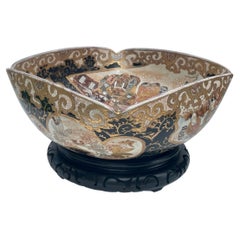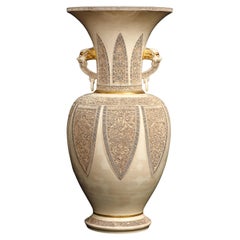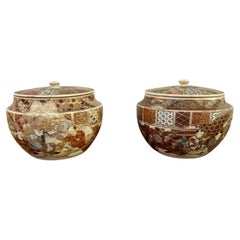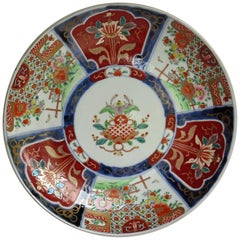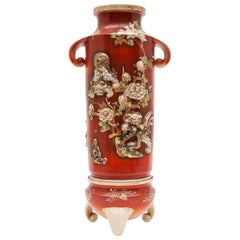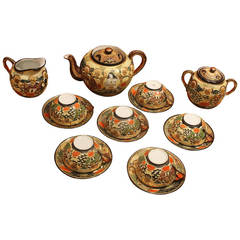Satsuma Ceramics
to
2
3
2
1
1
1
3
2
3
3
3
3
3
3
3
19
318
204
184
129
Creator: Satsuma
19th Century Japanese Satsuma Porcelain Water Well Bucket, Wishing Well Vase
By Satsuma
Located in Vero Beach, FL
This Japanese porcelain vase is barrel shaped with a yolk handle. It is both finely and intricately hand painted. It pictures groups of scholars with scrolls dressed in elaborate brocade kimonos...
Category
Late 19th Century Japanese Meiji Antique Satsuma Ceramics
Materials
Porcelain
$600 Sale Price
20% Off
Japanese Meiji Period Satsuma Large Square Bowl Centerpiece
By Satsuma
Located in Vero Beach, FL
Japanese Meiji Period Satsuma large square bowl
Antique early Meiji Period 15" square with scalloped rim Satsuma bowl. Highly unusual and finely painted. ...
Category
19th Century Japanese Meiji Antique Satsuma Ceramics
Materials
Ceramic
$4,160 Sale Price
20% Off
Rare Japanese Meiji Satsuma Crackle Ware Vase w/ Carving by Tashiro Factory
By Satsuma
Located in New York, NY
A Rare Japanese Meiji Period Satsuma Porcelain Double-Handled Crackled Ware Vase with Intaglio Carved Decoration and Gilt Adornment, Mark on Base: Tashiro Factory / Tashiro Giyōemon ...
Category
Early 1900s Japanese Meiji Antique Satsuma Ceramics
Materials
Porcelain
Related Items
Unusual quality pair of antique Japanese Satsuma lidded jars
Located in Ipswich, GB
Unusual quality pair of antique Japanese Satsuma lidded jars, having two antique Satsuma lidded jars, decorated with traditional Japanese figural scenes hand painted in stunning red,...
Category
Early 20th Century Japanese Satsuma Ceramics
Materials
Ceramic
Japanese Porcelain Charger finely Hand Painted, Meiji Period circa 1880
Located in Lincoln, Lincolnshire
This is a good quality, hand decorated Japanese porcelain charger, large plate or bowl with an Imari pattern, dating to the late 19th centur...
Category
Late 19th Century Japanese Meiji Antique Satsuma Ceramics
Materials
Porcelain
Japanese Modern Incenso Incense Holders Raku Ceramics Green Copper
By LAAB Milano
Located in monza, Monza and Brianza
An extraordinary addition to a contemporary decor for a stunning visual allure, this incense holder features a raw, porous shape deftly handcrafted and fire with the Raku Japanese...
Category
21st Century and Contemporary Italian Modern Satsuma Ceramics
Materials
Ceramic
$130 / item
H 0.71 in W 3.15 in D 10.24 in
19th Century Japanese Hand-Painted Blue and White Porcelain Charger Plate
Located in Yonkers, NY
A Japanese porcelain charger plate from the 19th century, with hand-painted blue and white blooming tree, rocky formation and bird décor. Created in Japan during the 19th century, th...
Category
19th Century Japanese Antique Satsuma Ceramics
Materials
Porcelain
Pair Antique 19th Century Japanese Imari Porcelain Plates, circa 1890's
Located in New Orleans, LA
Pair antique 19th century Japanese Imari porcelain plates, circa 1890's.
Category
19th Century Japanese Antique Satsuma Ceramics
Materials
Porcelain
Japanese Yunomi Tea Cup Raku Ceramic Silver Band
By LAAB Milano
Located in monza, Monza and Brianza
Yunomi is the taller tea cup, compared to the Chawan ( that has a usage during the tea ceremony ), which has a more formal everyday tea-drinking use. The Japanese design is elegant a...
Category
21st Century and Contemporary Italian Modern Satsuma Ceramics
Materials
Ceramic
Antique 19th Century Japanese Satsuma Vase Richly Decorated Marked Base Japan
Located in Amsterdam, Noord Holland
Lovely etailed piece. Marked on base with makers mark and mon crest
Condition
Overall condition perfect. Size: 294mm
Period
Meiji Periode (1867-1912).
Category
19th Century Japanese Meiji Antique Satsuma Ceramics
Materials
Earthenware
$852 Sale Price
20% Off
H 11.58 in Dm 0.04 in
Pair of Japanese Satsuma 'Moriage' Porcelain Gilt Vases
By Satsuma
Located in LA CIOTAT, FR
This handsome pair of 20th century glazed and gilded Japanese Satsuma vases, with their vivid, jewel-like colours and elegant baluster-shaped forms, feature the traditional Japanese ...
Category
20th Century Japanese Satsuma Ceramics
Materials
Porcelain
Japanese Satsuma Dragon Vase, Meiji Period, c 1900, Japan
By Satsuma
Located in Austin, TX
A fantastic small Japanese Satsuma vase with image of writhing dragons, Meiji Period, circa 1900, Japan.
The vase of elegant baluster form, with a slightly flared foot, slender body...
Category
Early 1900s Japanese Meiji Antique Satsuma Ceramics
Materials
Ceramic, Porcelain, Pottery, Stoneware, Hardwood
Antique Pair 19C Japanese Satsuma High Quality Black Vases Landscape Uchida
Located in Amsterdam, Noord Holland
Description
A pair of Japanese Satsuma black-ground vases, Uchida marks, Meiji/Taisho period
Of ovoid form with everted rims, painted in gilt with scenes of Mount Fuji against a bl...
Category
19th Century Japanese Meiji Antique Satsuma Ceramics
Materials
Porcelain
$1,797 Sale Price / set
20% Off
H 5.01 in Dm 2.37 in
Meiji Period Japanese Igezara Transferware Plate with Phoenix and Foliage Motifs
Located in Yonkers, NY
A Japanese Meiji period Igezara transferware plate from the late 19th century, with phoenix and foliage motifs. Created in Japan during the Meiji era, this Igezara transferware plate...
Category
Late 19th Century Japanese Meiji Antique Satsuma Ceramics
Materials
Pottery
$700
H 1 in Dm 15.75 in
Celadon Crackle Glaze Small Vase, China, Contemporary
Located in New York, NY
Contemporary Chinese small celadon crackle glaze vase.
Contrast tan band at opening.
The crackle glaze gives the vase the appearance of a vintage vase.
Two are available and sold ind...
Category
21st Century and Contemporary Chinese Satsuma Ceramics
Materials
Ceramic
Previously Available Items
Pair of Antique Red 19th Century Satsuma Vases, Japan
By Satsuma
Located in Antwerp, BE
Antique Japonese vases with three-footed stands, marked.
Meiji period (1868-1912) of one of the best Japanese makers for export to the European market.
A pair of ceramic hand paint...
Category
1890s Japanese Japonisme Antique Satsuma Ceramics
Materials
Ceramic, Paint
Japanese Mid - 20th century Satsuma Tea/Coffee set
By Satsuma
Located in Firenze, IT
Consisting of everything you need to serve tea or coffee. This beautifully hand-painted fine porcelain tea/coffee service with its decorations "Kozan" (1842-1916) and its gold leaf a...
Category
19th Century Japanese Antique Satsuma Ceramics
Satsuma ceramics for sale on 1stDibs.
Satsuma ceramics are available for sale on 1stDibs. These distinctive items are frequently made of ceramic and are designed with extraordinary care. There are many options to choose from in our collection of Satsuma ceramics, although gray editions of this piece are particularly popular. Prices for Satsuma ceramics can differ depending upon size, time period and other attributes — on 1stDibs, these items begin at $750 and can go as high as $5,200, while a piece like these, on average, fetch $2,975.
Questions About Satsuma Ceramics
- Is Satsuma pottery valuable?1 Answer1stDibs ExpertApril 26, 2024Yes, some Satsuma pottery is valuable. The age, type, style and condition will determine how much a particular piece is worth. In addition, the history of ownership may also make a piece more valuable. For example, if a piece was previously in the collection of a notable person, such as a member of the Japanese Imperial Family, it may be worth more. To get an estimated value for a particular piece, consult a certified appraiser or knowledgeable antiques dealer. Find a range of Satsuma pottery on 1stDibs.
- 1stDibs ExpertApril 5, 2022Satsuma porcelain or pottery includes a maker’s mark with the name of the person who made the item. Japanese numbers may also indicate that a Satsuma piece was part of a collection. Genuine Satsuma pieces will not have a “Made in Japan” label and should only include Japanese characters. When in doubt, work with a certified appraiser to determine the authenticity of your Satsuma piece. Find a variety of expertly vetted Satsuma porcelain and pottery collectibles on 1stDibs.
- What is a Japanese Satsuma vase?1 Answer1stDibs ExpertOctober 12, 2021A type of Japanese pottery originated from Satsuma province in Japan is termed as Satsuma ware. A vase of this kind is known as a Satsuma vase. An interesting fact about Satsuma ware is that they feature a "makers mark" or marking as a key to help collectors unlock the value, age and authenticity of the piece. Shop a range of antique and vintage Japanese vases on 1stDibs.
- How do I date a Satsuma vase?1 Answer1stDibs ExpertMarch 22, 2022To date a Satsuma vase, study its mark. Vases made before World War II normally feature a mark in Japanese. A vase that says "Royal Satsuma" likely dates back to the late 20th century. You'll find a variety of expertly vetted Satsuma vases on 1stDibs.
- 1stDibs ExpertOctober 7, 2024The difference between Satsuma and moriage is that the former is a type of pottery, and the latter is a technique for decorating pottery. Satsuma pottery is the term for earthenware pottery from Japan's Satsuma region. Although there are different styles, the most common element of Satsuma pottery is a heavy, dark glaze. Moriage is the term for when potters add raised slip decorations to pottery, creating a three-dimensional effect. Some Satsuma pieces show off moriage details, while others do not. Shop a range of Satsuma pottery on 1stDibs.
- 1stDibs ExpertNovember 4, 2024To identify Satsuma pottery marks, you'll typically need to perform research using trusted online resources. Satsuma is a region in Japan known for its pottery, and many factories and artisans have operated there, including Kinkozan, Taizan, Yasuda, Choshuzan, Fuzan, Gyozan, Koshida and Maruni Kobe. Each maker has its own marks associated with it, and these typically are in Japanese kanji characters. You can compare the characters on your piece to pictures shared online to find a match. Alternatively, a certified appraiser or experienced antique dealer can help you identify your pottery markings. On 1stDibs, shop a selection of Satsuma pottery.
- 1stDibs ExpertSeptember 9, 2024Yes, some Satsuma pottery is worth something. Depending on their age, maker, type, style, condition and other factors, pieces may sell for a few hundred to several thousand dollars. Looking at sales and auction histories can give you a rough idea of the value of a piece. For a more definitive valuation, use the services of a certified appraiser or knowledgeable antique dealer. On 1stDibs, explore a collection of Satsuma pottery.
- 1stDibs ExpertFebruary 1, 2024One way to tell if your Satsuma vase is valuable is to look for markings on it. The oldest and typically most expensive pieces will usually have the Shimazu family crest — a circle with a cross through it — hand-painted on the bottom. If the piece is stamped with the marking or says "Made in Japan" in the Roman alphabet, it is a newer vase. Factors like the style of the vase and its condition will also impact its price. It's a good idea to have a certified appraiser or knowledgeable dealer evaluate your vase to determine its value. Find a variety of Satsuma vases on 1stDibs.

